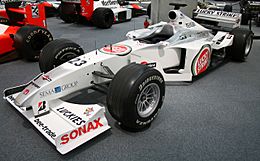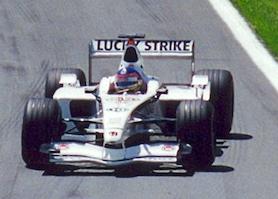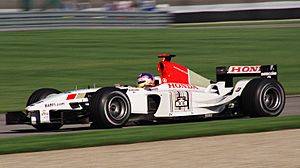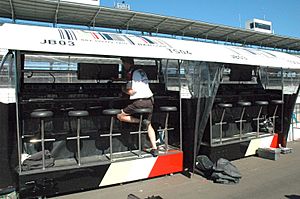British American Racing facts for kids
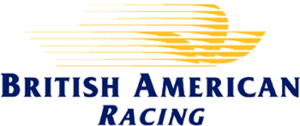 |
|
| Full name | British American Racing (1999) Lucky Strike BAR Honda (2000–2005) |
|---|---|
| Base | Brackley, Northamptonshire, United Kingdom |
| Founder(s) | Craig Pollock |
| Noted staff | Adrian Reynard David Richards Nick Fry Geoff Willis Ron Meadows Jörg Zander Willem Toet Andrew Shovlin Jock Clear |
| Noted drivers |
List
|
| Previous name | Tyrrell Racing |
| Next name | Honda Racing F1 Team |
| Formula One World Championship career | |
| First entry | 1999 Australian Grand Prix |
| Races entered | 118 (117 starts) |
| Engines | Supertec, Honda |
| Constructors' Championships |
0 (best finish: 2nd, 2004) |
| Drivers' Championships |
0 (best finish: 3rd, 2004, Jenson Button) |
| Race victories | 0 (best finish: 2nd, 2004 San Marino, Monaco, German and Chinese Grands Prix) |
| Podiums | 15 |
| Points | 227 |
| Pole positions | 2 |
| Fastest laps | 0 |
| Final entry | 2005 Chinese Grand Prix |
British American Racing (BAR) was a Formula One racing team. They competed in the sport from 1999 to 2005. BAR started by buying another team called Tyrrell.
For their first year, they used Supertec engines. After that, they teamed up with Honda. This partnership lasted for six years. The team was named after British American Tobacco (BAT), a company that owned and sponsored them. Their main office was in Brackley, Northamptonshire, United Kingdom.
In 2004, the Japanese car company Honda bought 45% of the team. By September 2005, Honda bought the rest of the team. This made Honda the full owner. Because of this, BAR Honda became the Honda Racing F1 Team for the 2006 Formula One season.
BAT continued to sponsor the team for a while. But new rules about tobacco advertising meant they stopped sponsoring Formula One completely by the end of 2006. Honda ran the team until 2008. After that, the team was sold to Ross Brawn. It became Brawn GP and had an amazing 2009 season, winning championships. Today, the team is known as Mercedes-AMG Petronas Formula One Team.
Team History
British American Tobacco (BAT) had been involved in Formula One for many years. Their brands were often seen on F1 cars.
In 1997, a person named Craig Pollock convinced BAT to buy the Tyrrell Formula One team. The deal was worth about £30 million. The team was still called Tyrrell in 1998. Then, in 1999, it officially became BAR.
Getting Ready to Race
On July 23, 1998, BAR announced a big signing. They got Jacques Villeneuve, who was the 1997 World Champion, to join their team for the 1999 Formula One season. Villeneuve's manager was Craig Pollock. A new driver, Ricardo Zonta, also joined the team.
The team's car was built by Reynard Motorsport in a new factory in Brackley. It used Supertec engines, which were actually rebadged Renault engines.
When BAR showed off their new car, they had a unique idea. Villeneuve's car was red and white, showing the Lucky Strike brand. Zonta's car was blue and yellow, showing the 555 brand. However, Formula One rules say that a team's cars must look mostly the same. BAR tried to fight this rule, but they eventually had to change. To get around the ban, they painted one side of their cars in Lucky Strike colors and the other side in 555 colors! For the 2000 Formula One season onwards, they used a more traditional look.
BAR had a slogan: "A tradition of excellence." Many people found this funny because the team was brand new and had no history yet.
1999 Season: A Tough Start

The first season for BAR was very difficult. They did not score a single point in the Constructors' Championship. They were the only team that year not to score any points. The car was quite fast and often qualified well. For example, in the 1999 Spanish Grand Prix, Villeneuve was briefly in third place.
However, the car often broke down during races. Villeneuve had 11 straight retirements at the start of the season. He finally finished a race in Belgium. Both Villeneuve and Zonta had serious crashes during qualifying in Belgium. This was reportedly because they bet they could take a famous corner called Eau Rouge at full speed.
Zonta got hurt during practice for the 1999 Brazilian Grand Prix. He missed that race and the next three. Mika Salo filled in for Zonta. Salo helped the team get its best finish of the season, 7th place, at San Marino.
2000 Season: Getting Better with Honda
During the 1999 season, BAR announced that Honda would supply their engines starting in 2000. This was a big deal because Honda also sent their staff to work with the team. It was the first time Honda was directly involved in Formula One since 1992.
The new Honda-powered BAR car showed a lot of improvement in 2000. It was much more reliable than their first car. The team's best finish was 4th place. They finished 5th in the Constructors' Championship. This improvement convinced Villeneuve to stay with the team.
2001 Season: Podiums and Consistency
In 2001, Villeneuve finished on the podium twice for BAR. However, his results and those of his new teammate, Olivier Panis, were not always consistent. Panis only scored points in two races. Villeneuve scored points in four races, including his two podiums. BAR finished 2001 in 6th place.
2002 Season: Changes in Leadership
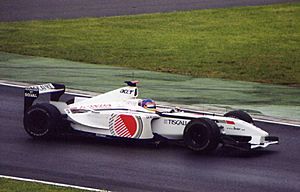
The team's owner, British American Tobacco, wanted changes. So, Craig Pollock stepped down as team principal. David Richards took over. Many staff members also left the team.
In 2002, BAR struggled to score points. Villeneuve and Panis both had a hard time. BAR only scored points in three races. They finished 2002 in 8th place in the Constructors' Standings. Even though they struggled, BAR made a deal to be Honda's only team starting in 2003.
2003 Season: New Drivers and Tyres
BAR brought in Jenson Button to replace Panis for the 2003 Formula One season. Villeneuve's contract talks with David Richards did not go well. He was replaced before the end of the season by Japanese driver Takuma Sato. Honda often likes to have Japanese drivers on their teams.
Jenson Button led a race for the first time at the 2003 United States Grand Prix. The team had some difficulties because they were using Bridgestone tyres. During the break before the next season, they switched to Michelin tyres.
2004 Season: The Best Year
The 2004 Formula One season was BAR's best year. Jenson Button finished on the podium many times. He also got the team's first ever pole position at San Marino. BAR finished the season in 2nd place in the Constructors' Championship. They were only beaten by Ferrari. Even with all this success, BAR still did not win a race.
During 2004, there was a disagreement with the WilliamsF1 team. Both teams thought they had a contract for Jenson Button to drive for them in 2005. The issue went to a special board, which decided that Button would stay with BAR for 2005. However, he did sign a contract to join Williams for 2006.
Because of new rules about tobacco advertising, there were rumors that BAT would sell the team. In November 2004, BAR announced that Honda had bought 45% of the team. David Richards left, and Nick Fry became the new team principal.
2005 Season: Challenges and a Ban
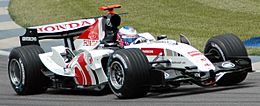
The start of the 2005 Formula One season was not good for BAR. They struggled in the early races. Then, at the 2005 San Marino Grand Prix, BAR Honda was disqualified. This meant their cars were found to be illegal. The team was also banned for two races, including the important Monaco Grand Prix.
When BAR returned to racing, they found it hard to get back on track. Unlike the year before, BAR did not score any points until the middle of the season. This was also made harder because their Michelin tyres caused them not to start the 2005 United States Grand Prix. Takuma Sato had a tough season, scoring only one point. He left the team at the end of the year. Rubens Barrichello replaced him in the new Honda team.
Jenson Button scored points in the last 10 races of the season. He also got two podium finishes. At the end of 2005, Honda bought 100% of BAR from British American Tobacco. This meant Honda became a full Formula One car manufacturer team. Jenson Button also signed a new contract to stay with Honda.
Speed Record Attempt
BAR tested a special version of their BAR-Honda 007 car. They wanted to use it to set a new land speed record for a Formula One car. The team aimed to reach 400 kilometers per hour (249 miles per hour). They planned to try for the record at the Bonneville Salt Flats.
The driver for this project was Alan van der Merwe. The car was tested on a long runway in California on November 5, 2005. During this test, the car reached speeds of 393 km/h, 405 km/h, 410 km/h, and 413 km/h. However, this was just a test, not the official record attempt. The salt flats later became too wet, so the attempt was postponed. BAR's successor team, Honda, used the car to set a new record the following year.
Images for kids
See also
 In Spanish: British American Racing para niños
In Spanish: British American Racing para niños


